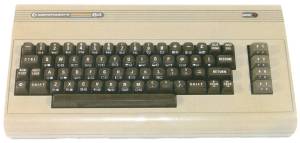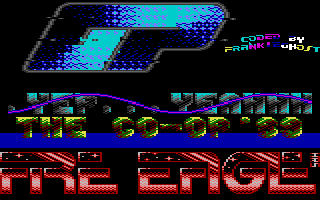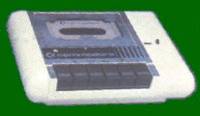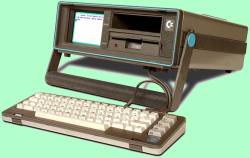
|
Manufacturer |
Commodore (US) |
Model |
64 |
Date Launched |
December 1982 in UK |
Price |
£345
Soon reduced to £200 |
Microprocessor type |
MOSTEK 6510 @ 1 MHz
(A version of the 6502 with memory switching so that it could access more than 64 KB of memory.) |
ROM size |
20 kilobytes |
Standard RAM |
64 kilobytes |
Maximum RAM |
64 kilobytes |
Keyboard type |
Typewriter style |
Supplied language |
BASIC |
Text resolution |
40 x 25 characters |
Graphics resolution |
320 x 200 pixels |
Colours available |
16 |
Example Screenshot |

The Commodore 64 could produce very colourful displays.
|
Sound |
Advanced 3 channel sound through internal speaker using custom SID chip. |
Cassette load speed |
300 baud
 Required a special cassette recorder, the C2N, costing £40. This recorded binary data digitally using pulse width modulation, rather than as audio signals of two different frequencies like most home computers. Required a special cassette recorder, the C2N, costing £40. This recorded binary data digitally using pulse width modulation, rather than as audio signals of two different frequencies like most home computers. |
Dimensions (mm)
Weight (grams) |
404 x 216 x 75
1280 |
Special features |
Video controller could generate 8 hardware 'sprites'.
Total ROM + RAM could be more than 64 KB. |
Good points |
Large memory.
Very advanced graphics and sound.
Enormous number of software titles available. |
Bad points |
The supplied version of BASIC was very poor and made it difficult to access the graphics and sound capabilities of the machine.
VIC 20 cartridges could not be used.
The 40 column display was not ideal for business software.
Commodore 64s had a reputation for being unreliable. |
How successful? |
The best selling home computer in the world, and probably the second highest selling in the UK, after the Sinclair Spectrum.
Estimates of sales vary somewhat but worldwide about 20 million Commodore 64s were sold. |
Comments |
Although the Commodore 64 was almost identical in appearance to the VIC 20 the internal hardware was much more advanced.
It had some of the best graphics and audio abilities of any home computer in 1982 and after the price was reduced to £200 it represented better value for money than the likes of the Acorn BBC B at £400. (Although once the special cassette recorder and a cartridge with a decent version of BASIC were included the cost of the C64 rose to around £260.)
Review of the Commodore 64
The '64' was used almost exclusively as a games machine even though Commodore also tried to promote it as a business computer. It was actually better in most respects than the vastly more expensive IBM PC Jr being sold at the same time, but never found favour with businesses.
 In 1984 Commodore produced a portable version of the '64', called the SX-64. This was essentially a standard Commodore 64 in a stylish case, with a 5 inch colour screen and a 170K, 5¼ inch floppy disk drive. The machine was self-contained but needed mains power. In 1984 Commodore produced a portable version of the '64', called the SX-64. This was essentially a standard Commodore 64 in a stylish case, with a 5 inch colour screen and a 170K, 5¼ inch floppy disk drive. The machine was self-contained but needed mains power.
Although the SX-64 was theoretically software compatible with the standard model, it lacked a cassette interface so programs stored on tape could not be loaded into it. Together with the high price of £900 this meant few SX-64s were sold. |

